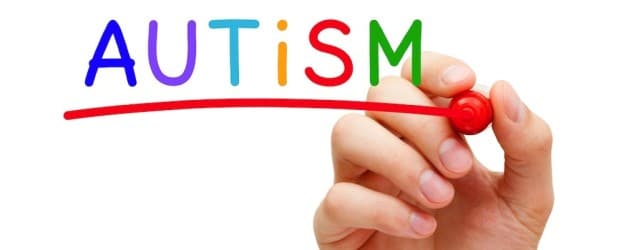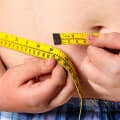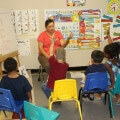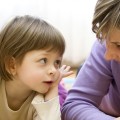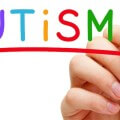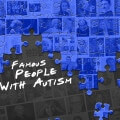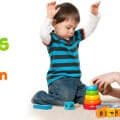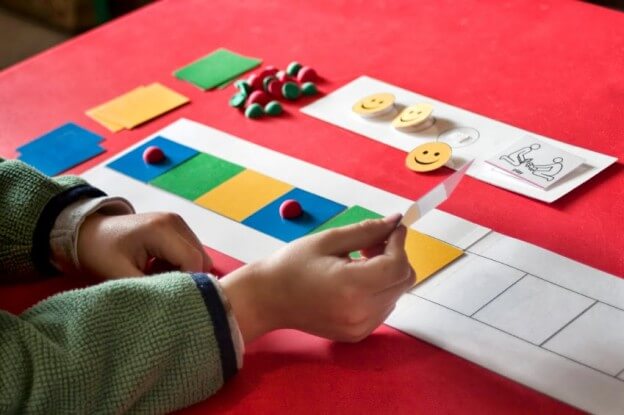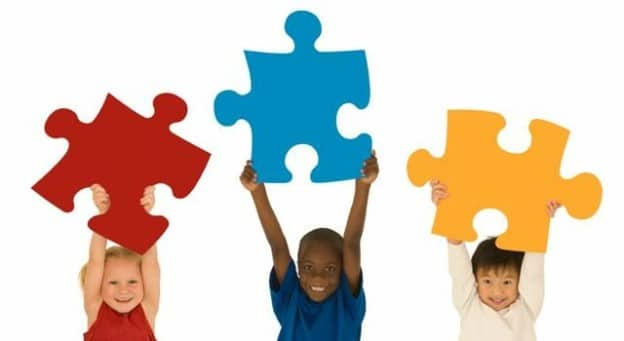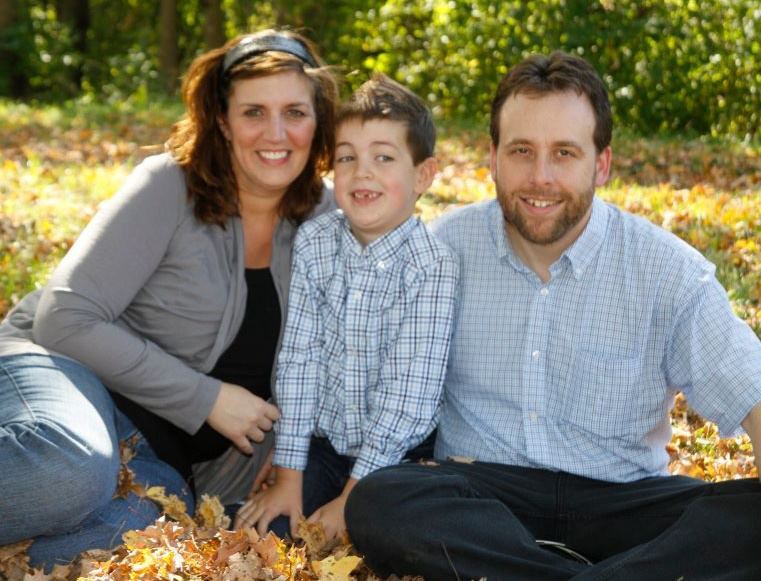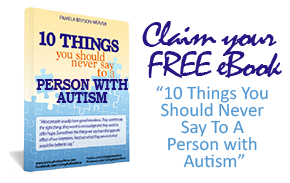TRUST ~~~ WHEN YOU CAN TRUST THE PERSON WHO WROTE A BOOK YOU ARE OF TO A RUNNING START TO BE BLESSED! When that person knows the subject that they are not only putting into words, but have already paid the price for the information being shared – you will also be enriched by what you read. HOPE ~ There is always a need and a source for HOPE> Pamela knows how to reach out with her words to do just that: H- helping O- other P- people E – endure. In fact, with the Lord’s guidance she does more than just help folks dealing with this heath challenge to ‘endure’ but be overcomes!
Archives
M. Brooks
The author delivers the most intimate truths about her life in the most genuine way. She sheds a light on the highs as well as the lows. I believe this book will not only benefit the families living directly with autism but also those on the outside; such as myself. It has helped me to have a better understanding of the inner life of autism. She has brought a guide that can be used for all to cope, understand, and learn while keeping it simplistic in terminology and personal so we can empathize with the emotions. I highly recommend this book to anyone as it has the ability to help you find hope and gratitude. Well done!
Dad of Divas (www. dadofdivas.com)
While I do not live with autism daily, this was an interesting read. I appreciated how in-depth the author was in regards to what parents have to deal with in an honest, upfront and truthful manner. The book was easy to understand and the author talks to you as if you are a trusted friend. That being said I was very impressed with the amount of information that was shared and I can honestly say that I learned SO much from reading this that I was not aware of previous to reading. The book is definitely a resource that will offer hope and resources for anyone touched by autism. The daily reflections really make you think differently about autism and what this means to you and the people around you!
*I received this for review – all opinions are my own*
Kelly
When I received Pamela Bryson-Weaver’s Living Autism day-by-day, I knew that it would be of interest to several moms that I know.
It begins with an informational intro, then transitions into a journal of sorts. Each day has a story, quote, and /or info, and has a space for notes or reflections. It’s a great hybrid of clinical information and lovely thoughts and quotes. I thought it would be a great resource and personal notebook for the parent of an ASD child.
I gave the book to a friend and asked for her review, as someone who is very knowledgeable on the subject and truly is living autism day-by-day. Below are her thoughts:
“I appreciate Mrs Bryson-Weaver’s positive breath of fresh air on a variety of topics that are very difficult for most parents of an ASD child. Daily she provides a famous inspirational quote, a topic to revel over, and a small daily objective to strive for. She covers advocating for the ASD child as well as advocating for yourself to find the answers you seek, the support you need, and acceptance of your child for who they are.
Her knowledge and suggestions are current in terms of biomedical and dietary treatment approaches. I’m not so sure that all of her ideas are reasonable though. As a mother myself of a child with an ASD, I was quite surprised to find her “home schooling” suggestion.
On a whole, the book is a must read for parents of a newly diagnosed child!!”
Understanding Autism Spectrum Disorders
Autism is a wide spectrum of disorders that overlap among each other yet, has distinct characteristics making each case unique even among siblings. Collectively, they are called Autism Spectrum Disorders (ASD). Any of these disorders can affect both children and adults. Currently, it has NO known cures. They are also genetic in nature. According to recent data from CDC, this developmental disorder affects 1 out of every 68 children in the US alone. Though it is known to affect more boys than girls, grouping together a child’s symptoms can be tough. To understand ASD better, here are some basic markers to consider:
Autistic Disorder
Simply referred to as “autism,” it is also recently being described as “mind-blindness” or the lack of Theory of Mind creating major barriers in communication and socialization. This collection of neurological and developmental disorders is usually diagnosed in the first 3 years of life. A child with autistic disorder engages in repetitive behaviors, appears to have a world of his own, shows little or no interest in others, and has obvious lack of social awareness. A child with autism is often focused on consistent routine with interest transfixed in repetitively odd or peculiar behavior. Almost always, children with autism have communication issues, avoid direct eye contact, and manifests limited attachment to others.
Regressive Autism Spectrum Disorder
Regressive ASD is sometimes referred to as autistic regression or autism with regression, or acquired autistic syndrome and setback-type autism. It usually occurs when a seemingly normal child starts to lose speech and social skills from 15-30 months of age. Amid researches and studies done over the years, however, there is still no definite distinction between autism with- and without regression. Some believe that this type of autism is just an early-onset autism diagnosed at a later date. Some features early delays while others are diagnosed after later losses. This is believed to affect approximately 20-30% of children in the spectrum.
Pervasive Developmental Disorder – Not Otherwise Specified (PDD-NOS)
Called PDD-NOS or atypical personality development, this type of autism refers to the “sub-threshold” condition wherein some, but not all, features of ASD or other explicitly identified PDD are identified in a child. PDD-NOS is a diagnosis which covers cases marking impairment of communication, social interaction, stereotyped behavioral patterns and interest—but does not include autism’s full features or explicitly defined pervasive personality disorder/PDD. Take note that most of those in PDD-NOS have less impaired social skills than those in “classical” autism.
Asperger’s Syndrome
Also known simply as Asperger’s or Asperger Disorder, this ASD is usually diagnosed between the ages 2-6. A child with Asperger’s manifests good verbal skills and good cognitive skills but is rather clumsy, socially awkward, and often engages in odd, repetitive behaviors and interests. This is named after Austrian pediatrician, Hans Asperger, who conducted a study on a group of children in 1944.
Childhood Disintegrative Disorder
Known as Heller’s syndrome or disintegrative psychosis, this type of ASD is very rare. Children with seemingly normal development suddenly lose motor, social, and language skills around the ages 2 to 4. This severe regression usually presents a dramatic loss of skills and can develop later than autism does.
Rett Syndrome
Coined after Dr. Andreas Rett’s study, Rett’s Syndrome or Rett’s Disorder is a condition that used to be called cerebroatrophic hyperammonemia. This is an extreme form of ASD characterized by zero verbal skills with 50% not being able to walk. Most of those who have Rett’s have small hands and feet, with notable deceleration of head growth, repetitive stereotypical hand movements, and some 80% experience seizures. Scoliosis, growth failure, and other gastrointestinal disorders are also common for children with Rett’s Syndrome. Almost all of the cases reported under this spectrum occur in girls, but studies reveal that this can also affect boys.
As more and more research is being conducted on Autism Spectrum Disorders, we can only surmise that more type of autism will come out soon. Geneticists recently pointed out that the right term to be used is “autisms”(plural) rather than “autism” due to the variety of genetic forms the developmental disorder represents.
When diagnosing Autism, parents should seek professional diagnoses from specially trained professional, including pediatricians, psychologists, and others. List can be found at http://livingautismnow.com/directory/ for Canada, http://www.autism.org.uk/directory.aspx for the UK, and http://www.autism-society.org/ for the US.
Pamela Bryson-Weaver is the author of Living Autism Day by Day: Daily Reflections and Strategies to Give You Hope and Courage, a #1 bestseller on amazon.com. A staunch advocate for autism, she is also the mind behind the powerful website—www.livingautismnow.com—an online portal for parents, caregivers, individuals with ASD, service providers, and experts to interact with each other, to raise awareness, and locate the best possible services for them. Bryson-Weaver is uniquely qualified to speak on autism as she is the past president of the Autism Society in New Brunswick, and has promoted a resolution on autism that was presented locally, provincially and nationally, and was passed nationally in Canada 2004. To date, all children diagnosed with Autism Spectrum Disorder in her province receive S20k per year for treatment. Married with 3 children, the main driving force in this advocacy is her youngest son, John, who has autism.
Sources:
Children’s Hospital of Wisconsin
WebMD
Livestrong
Yale School of Medicine
7 Ways to Choose the Right School for Your ASD Child
Choosing a school for your child with Autism Spectrum Disorder can be overwhelming. Not only will you be choosing a school that will make your child thrive, you need also to look into its educational values and the overall school’s reputation on how well it accepts Autism. You need to accept the fact that not all schools are as welcoming as they seem to be, no matter how they promote their campuses as such. As a parent to a child who is on the spectrum, it takes a lot of efforts and research to finally found one. To get you started, here are a few things to take note when shopping for a new haven for your child.
- Scrutinize the different schooling options available. Every child on the spectrum has a different requirement and needs. You need to remember that what could work for another child on ASD might not exactly work for yours.
- Try to browse the net for schools in or near your area. Most schools nowadays are listed online and researching for those located near you can be such a breeze. Make a list of your preferred schools and schedule an appointment.
- Take time to sit and discuss with the school’s representative. During your visit, have a feel on whether the school staff is welcoming and how knowledgeable they are about ASD. It is also important to know if the school has a separate program for students with special needs or if they treat them as equals. Do not forget to check the schools extra-curricular programs. Some schools, especially with active Autism communities, have after-school programs specifically created to cater to children with developmental disorders. This is one great way to hone your kid’s abilities and to improve his social skills.
- If possible, do your visits on a typical school day where kids are abuzz with activities. School “open house” may prove to be welcoming because it is designed to be so. Try to come on “normal” school days to get the actual picture. When visiting, however, do not take your child with you. You will only be adding to his or her confusion that might become a prelude a dislike of schools.
- If you have done transitioning activities with your autistic child, ask the school staff or the principal if it is okay for him or her to do a “visit.” A few minutes of integration with other kids his age can be helpful but, do not overdo it. Limit it in as much as five to ten minutes. Be keenly observant to avoid any meltdown.
- Schools for kids with developmental disorders can be costly. There are schools though which proactively process application for additional funding to help families living with Autism. Check how their enrollment is usually processed.
- Check the school’s security system. Kids on the spectrum need to be in a secure environment due to their different level of vulnerability. Make sure the school has an iron-clad security system to protect your child with autism from harm, and even from bullying.
Indeed, finding a school with a positive vibe in it, and where children with autism are most welcome can be an arduous task. However, hope springs eternal as more and more schools in Canada are opening up to those living with Autism Spectrum Disorder. In all things else, choose one which you believe will make your child happy.
Teaching Your Community About Autism The Positive Way
Ever experienced having someone’s eyebrows raised over your autistic child?
Do you feel insulted or hurt?
It is a common occurrence among many communities across the globe for people to not instantly understand what your child is going through with this ordeal. However, you, as one who has direct knowledge about Autism Spectrum Disorders, have all the power in your hand to make people understand about it. The challenge is how to do it nicely without offending the other party.
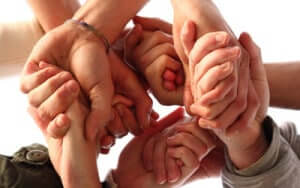 As we all know, some people that those living in the spectrum are dysfunctional and live in their own world. These observations, however, are but a minute part of the spectrum of disorders that the autism genome carries. If your child or a sibling has ASD, educating those around you can be done in a positive manner. You can start talking to neighbors about it. If you have community forums, joining in one and making your intentions known can also elicit awareness among those who surround your loved one with Autism.
As we all know, some people that those living in the spectrum are dysfunctional and live in their own world. These observations, however, are but a minute part of the spectrum of disorders that the autism genome carries. If your child or a sibling has ASD, educating those around you can be done in a positive manner. You can start talking to neighbors about it. If you have community forums, joining in one and making your intentions known can also elicit awareness among those who surround your loved one with Autism.
Start by educating them on the nature of the disorder, that is, Autism is neurological and not psychological as what others believe it to be. Add the fact that it is a spectrum of disorders meaning, ASDs have different levels of severity and not necessarily like Simon Lynch on Mercury Rising or Dustin Hoffman in Rain Main. Before you do this, it is imperative that you harness your knowledge about the spectrum of disorders that Autism carries to ensure that you get your point across as factually as possible. This could mean researching about your child’s diagnosis, interacting with medical professionals assessing his or her cognitive, language, developmental and social skills, and so on.
It is important to point out the challenging ways like making eye contact, showing appropriate emotions, and other manifestations affecting their social skills. Most kids with autism also has trouble accepting change and when faced with such, they can easily feel stressed and agitated making it hard for them to reach out and be understood. It is like being in the South of France with nary any idea about the language. It is how their brain works and they cannot help it, one puzzle no one has the obvious answer as to why. It is important to let people understand that an autistic’s reaction or lack thereof to certain stimuli is part and parcel of the disorder. Some manifests differently than others but, all the same, this neurological condition can bring in different reactions.
Be as factual as possible in your points. If talking to neighbors or friends, make them understand the diagnosis provided by your child’s doctor and the observations you have gathered over time. Along with facts, your attitude also plays a big role in making people that surrounds your child or sibling with autism understand what you and your child/sibling is going through. Not will this improve their interaction to people with ASDs, this will also increase their awareness and be able to relay this to others. Besides, word of mouth has always been an effective manner of raising awareness.
Photo credit: http://www.4-roads.com/Social/Blog/social-networks-vs-online-communities
Autism ABA Insurance Coverage: A Matter of Time
It has been known that Canada had led the northern pack in terms of finding appropriate treatment and therapy for Autistic Spectrum Disorders. Not only due to strong parental advocacies, the prevalence of tight-based community support systems also make Autism programs across many Canadian provinces to widen the scope of Autism health insurance coverage over the years. Yet, many insurance companies continually refuse to cover for ABA (applied behavior analysis) on the basis that it is “educational” or, in some cases filed, “experimental.”
As we all know, the effectiveness of ABA-based intervention on children with ASDs has been well documented for the last 5 decades or so. According to the American Academy of Pediatrics, children receiving early intensive ABA treatment have greatly shown substantial and sustainable gains not just in language and ID but also on academic performance, adaptive behavior and social conduct. Children with ASDs treated with ABA are also significantly better than those in control groups.
In a nutshell, ABA is a behavioral intervention to proactively treat ASDs and it is widely used by medical practitioners and caregivers directly involved in the pursuit to manage, if not to treat, autism. Most of us who have family members with Autism are not that unfamiliar with this therapy. Over the years, however, the insurance industry continually gives ABA the cold treatment as some of us might have also experienced with our private medical insurance. Well, there is hope that such could change nowadays.
With the recent statistics of 1 in 68 children having ASDs publicly declared and current declaration of Dr. Vera Tait, associate executive director of the American Academy of Pediatrics, debunking the “experimental” claims only on ABA, there is hope after all for families dealing with Autism Spectrum Disorder to enjoy a far wider coverage on their medical insurance for Applied Behavioral Analysis. According to Dr. Tait’s testimony before a subcommittee of the Senate Armed Services, a more flexible insurance coverage covering ABA should be afforded to families affected with ASD as the effectiveness of the treatment becomes more prevalent. All one needs is an appropriate diagnosis by a certified physician and declaration of ABA as a medical therapy for the individual with ASDs.
With this breakthrough, the autism communities across the US and, maybe, Canada in the near future will enjoy its positive impact. Not that it can cure ASD but mainly because it can be of great help in providing a more effective habilitative progress among kids with autism leading them to live a life they so rightfully deserve.
Autism At Home: Fun and Educational Activities For Kids On the Spectrum
Autism is a wide-ranging spectrum of disorders that can affect kids from all walks of life. Symptoms can vary from one individual to another but sometimes overlap making each autism spectrum unique. Often, parents have to work alongside developmental and behavioral needs specialists to address the symptoms and to prepare the individual for what lies ahead of them. To maximize results, however, certain home activities can be infused to the procedures and exercises done during therapy.
Responsible Parenting
As responsible parents, continuing the activities being taught and done during formal therapy sessions can be of great help. This requires a certain degree of keen observation and focus on the child’s core deficits. Three of the most common sources of frustration among children with autism are language impairment, over-sensitivity or lack thereof, and behavioral dilemmas. Learning what “triggers” their meltdowns and what makes them “happy” and calm can tremendously enhance his progress. The key is to work closely with professionals and keeping your line of communication open with them to open up the highway of possibilities for your child.
So, how to engage them in delightful and educational activities? Here’s how:
Let’s Get Physical
Gross motor skills development is essential to children with autism. Some fun activities that will help them develop such skills are: playing in the pool, simple obstacle course, disco party, sandbox playing, working out or children aerobics, and many more. The key here is for you (and perhaps, other siblings) to join in the foray to keep them safe as well as develop social integration.
Unleashing the Artist Within
Some kids with autism possess latent artistic talents waiting to be tapped. Your “little fidgety worm” might be the next Michelangelo or Van Gogh. Engaging him in activities like finger painting, clay sculpting, drawing on dry-erase markers, photography, collage, mosaic, and many more will help learn about colors, textures, and other art elements encouraging a more active sensory integration development.
Sex Education and Autism: Keeping Things in Perspective for Children With Autism
Sexuality has always been a taboo topic in society especially when kids are concern, so much more so when it comes to kids and teens with autism. Today, however, teaching about sexuality is considered a must to develop and enhance personal values with respect upon self and others as a basis. Sexual education is usually infused in school curriculum to teach children as early as 7 to understand and value themselves and others. This is one way of teaching them how to develop meaningful and respectful relationships later on.
To kids and teens with autism, the preparation and method can be quite comprehensive. Kids with autism are known to be socially challenged and often, have a hard time co-mingling with other, but this condition does not exempt them from being subjected to sexual harassment or abuse. By laying the foundation for them like correctly identifying body parts, clear understanding of human reproduction, learning about safety, and discovering family and interpersonal relationships will eventually develop their awareness and confidence.
The key in teaching children with autism about sexuality is by doing it gradually and according to their age and development. Be reminded that sexual education is not merely about sexuality per se but more on raising awareness and recognizing their own capabilities to better understand their bodies, relationship with others, and feelings deep within.
School Agenda on Sex Education for Autism
Sexual education is compulsory to most, if not all, school curriculum. The most fundamental aspect in educating children with autism about human sexuality is the literacy skill bestowed upon them. Amid their developmental needs, these children (most especially the teens) can now understand, interpret and assess outside and imagery messages (especially those coming from the media and the internet) correlated to relationships, sexuality, and gender.
Teachers usually raise awareness to students with autism about their body and to better understand the changes that come with it especially during puberty. It is important that they infuse key learning in a positive environment without discriminating gender. Often, raising awareness is inclined to dispel certain myths that students might hear or learned from outside influences especially from peer pressure. Often, this particular school curriculum provides a venue or forum to generate open communication between students with autism and parents.
Your Role As A Responsible Parent
Raising a child with autism can be tough. No doubt about it. However, we are tasked to make our kids independent and be confident enough to be able to sustain their needs and wants amid living in the wide-ranging spectrum of autism. It is our obligation to provide them information and knowledge consistent to what has been taught in school. It is understandable that it can be hard to some levels of autism severity but, when kids ultimately grow up, and the least we can do is to openly and honestly discuss with them issues on sexuality to better gear them when they reach puberty.
Aside from social issues, the most important aspect of sex education to children with autism is for their safety. Prevention of abuse must be foremost in the minds of parents, teachers and caregivers. From learning about themselves to personal hygiene, bathroom and locker room independence and safety, drawing the line between “good touching” and “bad touching”, proactively teaching our kids the right way about their sexuality can make them understand better about privacy thereby preventing them from becoming likely victims to predators prying on innocent kids.
